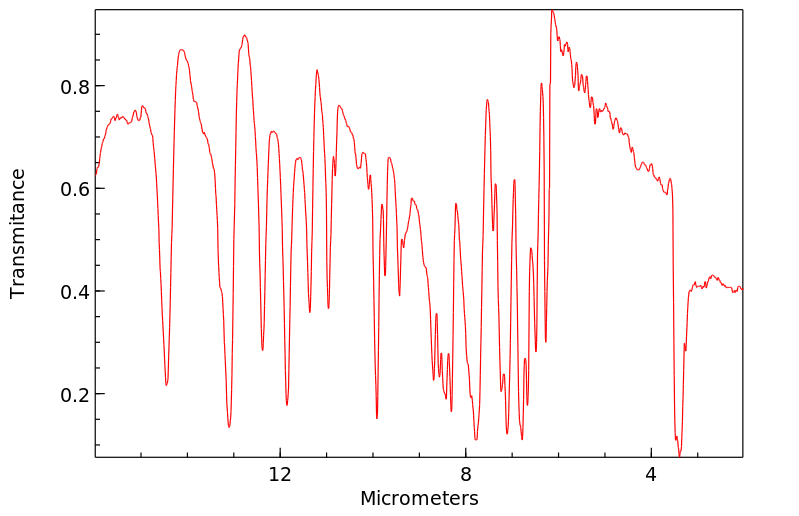2-苯氧基吡嗪 | 107697-82-5
中文名称
2-苯氧基吡嗪
中文别名
——
英文名称
(Pyrazine-2-yloxy)benzene
英文别名
2-phenoxypyrazine;phenoxypyrazine;phenoxy-pyrazine;Phenoxy-pyrazin
CAS
107697-82-5
化学式
C10H8N2O
mdl
MFCD28338625
分子量
172.186
InChiKey
LKXUZLSVURTETC-UHFFFAOYSA-N
BEILSTEIN
——
EINECS
——
-
物化性质
-
计算性质
-
ADMET
-
安全信息
-
SDS
-
制备方法与用途
-
上下游信息
-
文献信息
-
表征谱图
-
同类化合物
-
相关功能分类
-
相关结构分类
物化性质
-
熔点:73-74 °C
-
沸点:282.1±20.0 °C(Predicted)
-
密度:1.175±0.06 g/cm3(Predicted)
-
保留指数:1415;1415
计算性质
-
辛醇/水分配系数(LogP):1.6
-
重原子数:13
-
可旋转键数:2
-
环数:2.0
-
sp3杂化的碳原子比例:0.0
-
拓扑面积:35
-
氢给体数:0
-
氢受体数:3
SDS
反应信息
-
作为反应物:参考文献:名称:3-取代的N-酰基吡嗪鎓盐的区域选择性还原对1,2-二氢吡嗪的合成摘要:的3-取代的区域选择性还原Ñ -acylpyrazinium盐与Ñ -Bu 3 SNH已经开发了的3-取代的1,2- dihydropyrazines在56-94%的收率的合成。吡嗪鎓盐被供电子基团取代有利于1,2-异构体的形成,因为它们比1,6-异构体具有更好的稳定性。在温和酸性条件下,3-甲氧基取代的1,2-二氢吡嗪很容易在良好的收率水解为Δ 5 -2-氧代哌嗪。DOI:10.1021/jo202498r
-
作为产物:描述:phenyl pyrazine-2-carboxylate 在 bis(1,5-cyclooctadiene)nickel (0) 、 potassium phosphate 、 3,4-bis(dicyclohexylphosphino)thiophene 作用下, 以 甲苯 为溶剂, 反应 18.0h, 以50%的产率得到2-苯氧基吡嗪参考文献:名称:Pd和Ni催化合成脱羰二芳基醚摘要:由于二芳基醚作为药物和天然产物中的一个重要基序存在,因此已经对开发新方法进行了广泛的研究。构建二芳基醚部分的常规方法是芳基卤化物和酚与铜或钯催化剂的分子间交叉偶联反应。我们使用钯或镍催化剂开发了芳族酯的催化脱羰醚化,以及我们的使能二膦配体,以产生相应的二芳基醚。本反应可以以极好的收率以克规模进行。该反应不仅在分子内设置中起作用,而且还允许使用其他酚进行交叉醚化。DOI:10.1021/jacs.7b00049
文献信息
-
Etherification of Functionalized Phenols with Chloroheteroarenes at Low Palladium Loading: Theoretical Assessment of the Role of Triphosphane Ligands in CO Reductive Elimination作者:Mélanie Platon、Luchao Cui、Sophal Mom、Philippe Richard、Mark Saeys、Jean-Cyrille HiersoDOI:10.1002/adsc.201100481日期:2011.12tolerates very important functions in various positions, such as cyano, methoxy, amino, and fluoro groups, which is useful to synthesize bioactive molecules. DFT studies furthermore demonstrate that triphosphane ligands open up various new pathways for the CO reductive elimination involving the third phosphane group. In particular, the rate for one of these new pathways is calculated to be about 1000 times本研究强调了具有可控构象的稳健三齿二茂铁基膦烷在CO键形成反应中作为催化助剂的潜力。空气稳定的钯三膦体系通过使用低至0.2 mol%的催化剂,对于选择性杂芳基醚合成非常有效。这些发现代表了功能性酚,富电子,贫电子和对位,间位或邻位的酚在经济上有吸引力的清洁醚化-被取代的底物,其具有杂芳基氯化物,包括吡啶,羟基化吡啶,嘧啶和噻唑。醚化耐受各种位置的非常重要的功能,例如氰基,甲氧基,氨基和氟基团,这些功能可用于合成生物活性分子。DFT研究进一步表明,三膦配体为涉及第三膦基团的CO还原消除开辟了各种新途径。特别地,这些新途径之一的速率经计算比从具有相似二茂铁基配体但在底部Cp环上没有膦基的复合物进行还原消除的速率快约1000倍。计算了第三膦基与钯(II)中心的配位,以稳定该新途径中的过渡态,
-
ビ(ヘテロ)アリール(チオ)エーテル化合物の製造方法申请人:国立大学法人名古屋大学公开号:JP2017160139A公开(公告)日:2017-09-14【課題】ハロゲン由来の廃棄物を排出せずに、安価にビ(ヘテロ)アリール(チオ)エーテル化合物を合成する方法の提供。【解決手段】例えば下記式に示すように、式(1)で表される(チオ)エステル化合物をニッケル触媒(又はパラジウム触媒)、並びに配位子化合物の存在下に反応させ、式(2)で表されるビ(ヘテロ)アリール(チオ)エーテル化合物を得る製造方法。[Ar及びAr’は夫々独立に置換/非置換のアリール基又はヘテロアリール基;YはO又はS]【選択図】なし
-
Keratinocyte growth inhibitors and hydroxamic acid derivatives申请人:——公开号:US20030229113A1公开(公告)日:2003-12-11This invention relates to a keratinocyte-proliferation inhibitor comprising as active ingredient a compound having an activity of inhibiting the solubilization of heparin-binding EGF-like growth factor bound to cell membranes and a compound of the formula (I); 1 or pharmaceutically acceptable salt thereof, wherein R 1 , R 2 , R 3 are hydrogen atom or alkyl and X is substituted benzene or the like.
-
COMPOSITION AND LIGHT-EMITTING ELEMENT COMPRISING THE COMPOSITION申请人:Akino Nobuhiko公开号:US20100038592A1公开(公告)日:2010-02-18Disclosed is a composition comprising a compound having a pyrazine ring structure and a phosphorescent compound, wherein the compound having a pyrazine ring structure has a pyrazine ring structure represented by the general formula (1), (2) or (3): wherein R and R 1 independently represent a hydrogen atom or a univalent group and multiple R's and multiple R 1 's may be the same as or different from one another. Also disclosed is a polymer having a residue derived from the phosphorescent compound and the pyrazine ring structure.
-
Copper-Catalyzed Direct Syntheses of Phenoxypyrimidines from Chloropyrimidines and Arylboronic Acids: A Cascade Avenue and Unconventional Substrate Pairs作者:Amar Jyoti Bhuyan、Sourav Jyoti Bharali、Abhilash Sharma、Dhiraj Dutta、Pranjal Gogoi、Lakhinath SaikiaDOI:10.1021/acs.joc.2c00658日期:2022.9.2or their salts. In contrast to the general trend of delivering Suzuki–Miyaura cross-coupling products in reactions between aryl or alky halides and arylboronic acids, the substrate pairs used herein (chloropyrimidines and arylboronic acids) led to C–O bond formation under the reaction conditions. In total, 25 phenoxypyrimidines were successfully synthesized using the described protocol, 6 of which
表征谱图
-
氢谱1HNMR
-
质谱MS
-
碳谱13CNMR
-
红外IR
-
拉曼Raman
-
峰位数据
-
峰位匹配
-
表征信息
同类化合物
(反式)-4-壬烯醛
(s)-2,3-二羟基丙酸甲酯
([1-(甲氧基甲基)-1H-1,2,4-三唑-5-基](苯基)甲酮)
(Z)-4-辛烯醛
(S)-氨基甲酸酯β-D-O-葡糖醛酸
(S)-3-(((2,2-二氟-1-羟基-7-(甲基磺酰基)-2,3-二氢-1H-茚满-4-基)氧基)-5-氟苄腈
(R)-氨基甲酸酯β-D-O-葡糖醛酸
(5,5-二甲基-2-(哌啶-2-基)环己烷-1,3-二酮)
(2,5-二氟苯基)-4-哌啶基-甲酮
龙胆苦苷
龙胆二糖甲乙酮氰醇(P)
龙胆二糖丙酮氰醇(P)
龙胆三糖
龙涎酮
齐罗硅酮
齐留通beta-D-葡糖苷酸
鼠李糖
黑芥子苷单钾盐
黑海棉酸钠盐
黑木金合欢素
黑曲霉三糖
黑介子苷
黄尿酸8-O-葡糖苷
麻西那霉素II
麦迪霉素
麦芽糖脎
麦芽糖基海藻糖
麦芽糖1-磷酸酯
麦芽糖
麦芽四糖醇
麦芽四糖
麦芽十糖
麦芽六糖
麦芽五糖水合物
麦芽五糖
麦芽五糖
麦芽五糖
麦芽三糖醇
麦芽三糖
麦芽三糖
麦芽三塘水合
麦芽七糖水合物
麦芽七糖
麦法朵
麦可酚酸-酰基-Β-D-葡糖苷酸
麦利查咪
麝香酮
鹤草酚
鸢尾酚酮 3-C-beta-D-吡喃葡萄糖苷
鸡矢藤苷







